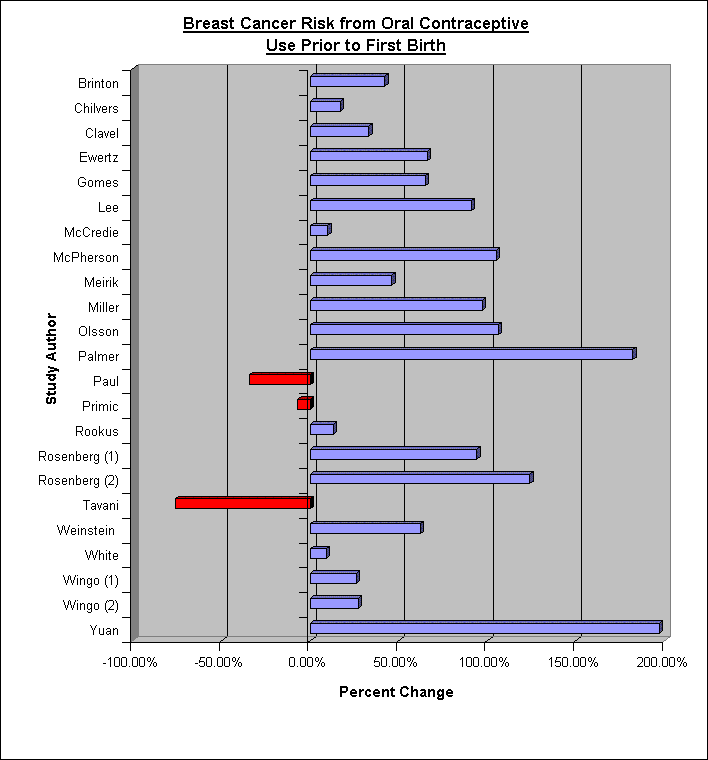
Posted on 02/16/2012 2:18:51 PM PST by NYer

There has been confusion of late concerning the World Health Organization’s International Agency for Research on Cancer (IARC) listing for their Group 1 Carcinogens, including several forms of oral contraceptives and estrogen replacement therapy. The confusion has arisen because the original link by WHO has been changed. After some sleuthing, here is a treasure trove of information from WHO. Let’s take the links one at a time.
First are the IARC Group Classifications for agents and their degrees of carcinogenicity:
Group 1 Carcinogenic to humans (107 agents)
Group 2A Probably carcinogenic to humans (59 agents)
Group 2B Possibly carcinogenic to humans (267 agents)
Group 3 Not classifiable as to its carcinogenicity to humans (508 agents)
Group 4 Probably not carcinogenic to humans (1 agent)
The definitions of these groups may be found in the IARC Monograph Preamble on the Evaluation of Carcinogenic Risks to Humans. Click here.
The page with links to the agents by various classification schemes may be found here.
The actual list of all agents, (IN Group number order) beginning with the following known (Group 1) carcinogens containing:
Estrogen therapy, postmenopausal
Estrogen-progestogen menopausal therapy (combined)
Estrogen-progestogen oral contraceptives
may be found by clicking here.
The same estrogens may be found on the list that lists them in alphabetical order with Group number next to their name. Click here.
Going much, much deeper…
There is another link that shows the monographs on:
1. Exposure Data
2. Studies of Cancer in Humans
3. Studies of Cancer in Experimental Animals
4. Other Data Relevant to an Evaluation of Carcinogenicity and its Mechanisms
5. Summary of Data Reported and Evaluation
6. References
for each of the following:
Oral Contraceptives, combined
Hormonal Contraceptives, Progestogens Only
Post-Menopausal Estrogen Therapy
Post-Menopausal Estrogen-Progestogen Therapy
The link to this page (which contains all the links to the monographs) may be found here.
Hopefully, this helps. Contrary to rumor, WHO did not hide the data, but actually expanded it in new links. Remember that even small increases in risk when multiplied by hundreds of millions of women taking these drugs will produce large absolute new cases of breast cancer.
P.S. Here is a monograph on all of the known carcinogens: Click here.
Catholic ping!
Looks like the government is trying to kill women!
Looks like the government is trying to kill women!

For instance, some commentators are trying to argue that European countries have successfuly shown that the almost-universal use of birth control has led to lowering abortion rates. But this is hard to prove.
Sometimes it's a matter of statistical confusion --- a confusion for which it's had to blame people, because it pervades the literature on family planning.
Let me give you an example. Pregnancy data and abortion rates are not collected and reported the same way in every country in the world. The much-heralded “lower” Dutch teen pregnancy and abortion rates used percentages based on all females under 20 years of age (including elementary school children), while ours are for adolescents ages 15 to 19. If you factor in prepubescent girls, as the Dutch do, you naturally you come up with a much smaller percentage who are unexpectedly pregnant or who have had an abortion.
One of the biggest reasons the Netherlands and other European countries have much lower abortion rates is that early abortions simply are not counted! If a young girl misses her monthly period and goes to a clinic, they don’t do a pregnancy test. They do a D&C (suction and scrape out her uterus) and call it a “menstrual extraction.” If there is no diagnosed pregnancy (no test to confirm), it is not reported as an abortion.
In short, much of the data commonly used to compare U.S. teen pregnancy and abortion data with other countries has not been adequately analyzed in terms of (1) differences in the statistical groups which form the basis for the comparison (all female children vs. all females between 15 and 20) and (2) differences in the reporting requirements for abortion (all procedures reported, vs. only the procedures which included a positive diagnosis of pregnancy.)
What is needed is a more careful evaluation of how pregnancy rates are reported from country to country.
An analysis of the Total Fertility Rate (TFR) of the European societies in which contraception is most universally accessible, shows that in every one of them the childbearing rate has plunged to far below the replacement level. The TFR of many of these countries (Greece 1.37, Italy 1.32, Romania 1.27, Belarus 1.25 ) show not sexual reproductive health, but demographic debacle.
Societies which have a collapsing childbearing rate may have also, I suppose, a low abortion rate. The disappearance of historic European societies, however, does not strike me as a positive outcome.
Disclaimer: Opinions posted on Free Republic are those of the individual posters and do not necessarily represent the opinion of Free Republic or its management. All materials posted herein are protected by copyright law and the exemption for fair use of copyrighted works.